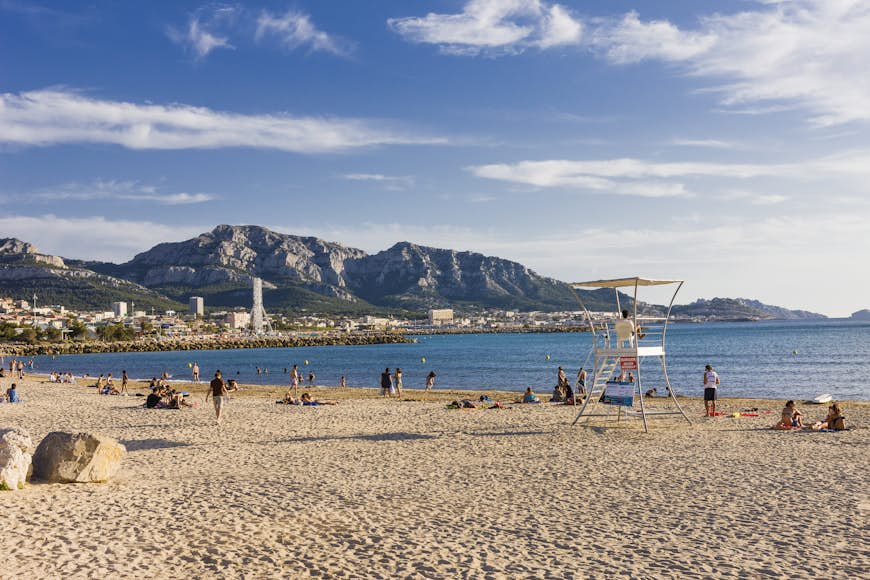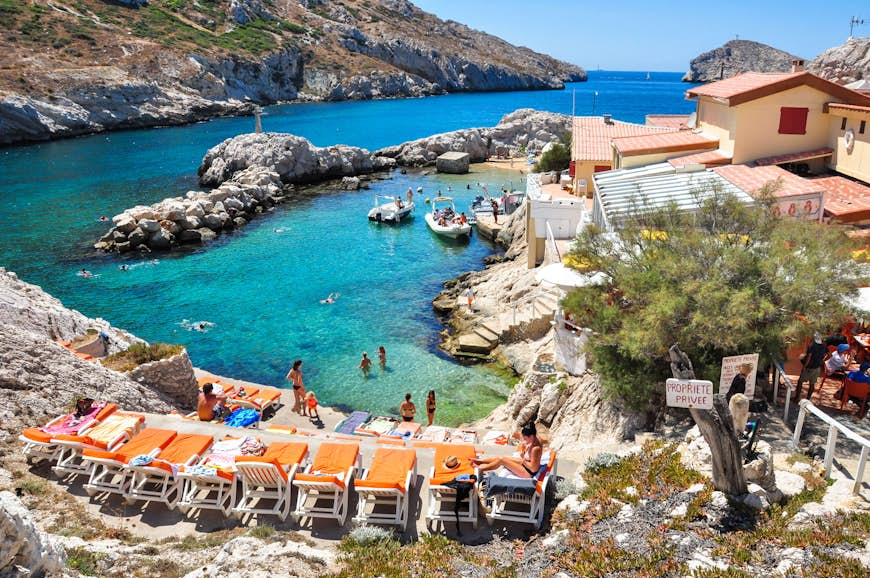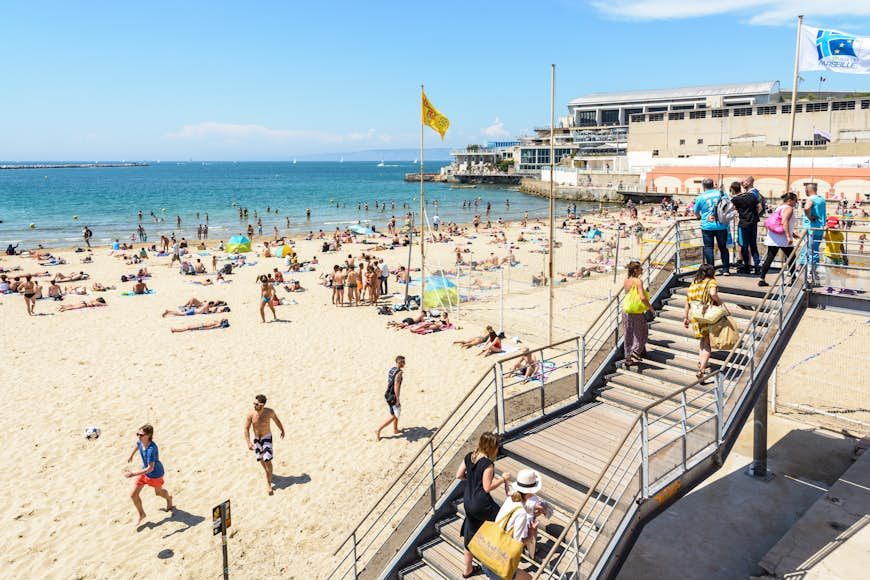This ancient Greek port and Roman colony might now be France’s second-largest city, but the sprawling metropolis of Marseille retains its seafaring charm.
Several mythical seaside towns – Cassis, Bandol in naturally glamorous Var, the Côte Bleue tangoing into flamingo-stitched Camargue – are all within an easy train ride of the Provencal capital. The Parc National des Calanques, meanwhile, contains a string of ravishingly wild inlets reached on foot or by boat.
But as every self-respecting Marseillais will proudly tell you, there’s no need to leave the city to find powder-soft golden sand, pebbled coves shaded by perfumed Aleppo pines and old-school rock ladders plunging into turquoise, gin-clear water. These are eight of the best.
Calanque de Marseilleveyre is best for lunch in the wild
A hike in Les Calanques is a Marseille rite of passage. In this national park, rocky footpaths spiral between maquis (herbal scrub), sun-scorched agaves and parasol pines to unveil larger-than-life vistas of the Med and vertiginous limestone cliffs plunging down to doll-sized calanques (coves) far below.
The best known (Calanques de Morgiou, Sormiou and En-Vau) get hideously overrun with tourists – an online booking system is being trialed at Calanque de Sorgiton this summer to limit visitor numbers to 300 a day. Avoid.
Head instead to the most delicious of local secrets: Calanque de Marseilleveyre. Pick up the signposted hiking trail to the paradisiac cove in Callelongue in the 8e; it should take about 50 minutes. Linger over lunch at Chez Le Belge, an isolated, ramshackle cottage with no electricity, no road access, no reservations – just a couple of plats du jour and salads, plastic tables and chairs on the sand – plus the most extraordinary tranquility and a view no money can buy. Paddling here by sea kayak is a fun option.
Plage des Catalans is best for urban dips, volleyball and underwater art
From the Vieux Port, walk 20 minutes or grab a public-sharing e-scooter to glide beneath Norman Foster’s giant mirrored canopy and west along Quai de Rive Neuve and Boulevard Charles Livon to the city center’s closest beach. Modest-sized and sheltered, it lured the first dippers in the 19th century and became wildly fashionable in the 1920s, when swimmers created the elite swim club Cercle des Nageurs de Marseille here.
Catalans’ legendary sands are the contemporary HQ for the city’s beach volleyball club. In between sea dips, watch bronzed players thump balls around on the court. Bring your own snorkeling gear to admire giant underwater sculptures at the Musée Subaquatique, Marseille’s most unusual museum, 100m (328ft) from shore at the bottom of the sea.
Pack beach refreshments, or reserve a table for a tapas lunch or early-evening drinks and kémia (Maghreb-style hors d’oeuvres) at Les Akolytes, across the traffic-noisy street from Plage des Catalans. Irresistible: traditional Marseillais panisses (chickpea pancakes with chili sauce), Camargue oysters and parmesan-laced sardine crumble.
Plage de la Bonne Brise is best for sunrise swims and sleepovers
Follow a local crowd to this small sandy beach (also called Plage de la Verrerie), tucked down a flight of steps between La Madrague de Montredon and Anse des Sablettes in the 8e arrondissement.
Views of Port de la Madrague are pretty enough, but the big draw is overnighting on the beach in a vintage cabanon de pêcheur (fisherman’s hut), with a weathered terrace gazing out to sea (you’ll find several on AirBnB.) Having the beach all to yourself once noisy sun-seekers have left for the day or waking up to a sunrise swim and breakfast alone on the sand is magic.

Plages du Prado is best for family fun
Bewitching views of seaside Marseille unfold along the coastal corniche that cruises 5km (3.1 miles) south from Catalans to Plages du Prado. Actually a trio of beaches, Prado is Marseille’s biggest and busiest seaside strip – red hot at weekends and in summer. Join locals chilling on the wide shingle beach, sunset smooching and lingering until late over takeaway pizza from one of the trucks parked along the 3.5km (2.2-mile) stretch.
Prado is Marseille’s prime daytime playground. Ogle the 1903 marble replica of Michelangelo’s David, kick a football around on the grassy lawn separating beach from traffic-clogged road, take the kids for a round of mini-golf or to the playground and flex your muscles at a street workout station. On the water, there’s sailing, sea kayaking and countless other nautical activities. Watching talented riders flip tricks in Prado’s hallowed “bowl” – a skate park of world renown – is a hypnotic highlight.
Île Degaby is the best desert-island beach
If it’s five-star luxury and paparazzi-free privacy you’re seeking, this uninhabited islet is all yours. It lies offshore from the picturesque port of Malmousque, near the iconic seafront restaurants of Le Petit Nice Passedat and Le Rhul.
The islet fort was built under Louis XIV in 1703, later used to isolate plague victims, and was gifted to music-hall star Liane Degaby by her wealthy industrialist husband in 1914. Lounge on parasol-shaded sun beds, swim from the deck, eyeball fish with a snorkel and enjoy the thrill of desert-island life.
The hitch? Degaby Island is the private beach of five-star Hôtel C2 – only accessible to hotel guests. Assuming your budget doesn’t stretch that far, vie with locals instead for a hotly contested spot on the Malmousque rocks to lay out your beach towel.

Plage de la Baie de Singes is best for beach chic and bouillabaisse
Prepare to be smitten. In the enchanting fishing village of Les Goudes in the 8e, wander by the picture-book strip of cottages on main street Rue Desirat Pelaprat and continue to Cap Croisette. On this windy and untamed lunar cape of sun-bleached limestone, ruined WWII bunkers and clumps of rare Astragale de Marseille (look for white-and-purple flowers in Spring), a narrow footpath cuts through white rocks to the sea and Monkey Bay.
Nicknamed Plage de Bout du Monde, this sandy beach on a teeny bay really does feel like the end of the world. Accessible only from La Baie des Singes restaurant, it’s the chic spot to chill with A-listers on orange sun-loungers, clamber across rocks and lunch on grilled sea bass, langoustine pasta and traditional bouillabaisse, Marseille’s signature fish stew. And the 360-degree views of the Med are out of this world.
Plage de la Pointe Rouge is best for sea walking with a city view
Hit this wide beach first thing and you won’t be the only person on the water, dotted with go-slow sea walkers in wetsuits and stand-up paddleboarders enjoying an early-morning work-out. Seafaring views of the Frioul islands and Bay of Marseille are incomparable.
Come noon, cheap eateries backing the beach and cafés with plastic tables on the sand burst into action. Grab a barquette de frites (fries), pizza slice or Nutella-smeared panini and join the hoi polloi enjoying a quintessential family day out at the seaside. Frequent buses and seasonal shuttle boats to the Vieux Port only add to Plage de la Pointe Rouge’s popularity.

Plage de St-Estève is best for marine biodiversity and snorkeling
Pack snorkeling gear and a picnic alongside your swimmers, and sail from the Vieux Port to Île Ratonneau (also called Île de Frioul) in the Frioul archipelago. Seabirds and rare plants thrive on this pinprick outcrop, and Plage de St-Estève is the spot to observe marine life up close.
The half-sand, half-shingle beach with cinematic views of Château d’If is a 20-minute walk from the port where Frioul If Express boats dock. In summer its family-friendly Sentier Sous-Marin (underwater trail), marked in the shallows by five buoys, encourages snorkelers to learn about Marseille’s rich indigenous marine life.
